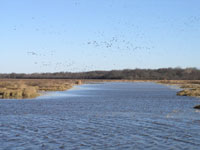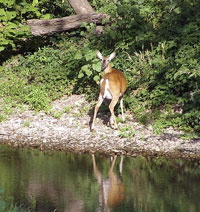Streams and Wetlands
 A "wetland" is an area that is inundated or saturated by surface or groundwater at a frequency and duration sufficient to support vegetation that is adapted for life in saturated soil conditions. Wetlands generally include swamps, marshes, bogs, and similar areas.
A "wetland" is an area that is inundated or saturated by surface or groundwater at a frequency and duration sufficient to support vegetation that is adapted for life in saturated soil conditions. Wetlands generally include swamps, marshes, bogs, and similar areas.
Wetlands perform many functions that result in successful and healthy ecosystems. The importance of wetlands can be grouped into three main categories:
Water Quality - Wetlands can act as a sink for sediments, inorganic and organic nutrients, and toxic materials. Various processes remove these materials from the water column, enabling them to be transformed into nontoxic substances, taken up by plants, or buried in soil or peat accumulations. This leads to improved water quality.
Wildlife Habitat - Wetlands also provide habitat to many fish and waterfowl.
 Hydrologic Processes - Wetlands influence the dynamics of water flow by intercepting and storing storm runoff from uplands and soaking up floodwaters from adjacent water bodies. Wetlands stabilize stream banks, and lake shores from the forces of stream flow. These hydrologic functions of wetlands are important in reducing flood damage, minimizing erosion, maintaining groundwater aquifers, and supporting base flows during the dry season for aquatic species.
Hydrologic Processes - Wetlands influence the dynamics of water flow by intercepting and storing storm runoff from uplands and soaking up floodwaters from adjacent water bodies. Wetlands stabilize stream banks, and lake shores from the forces of stream flow. These hydrologic functions of wetlands are important in reducing flood damage, minimizing erosion, maintaining groundwater aquifers, and supporting base flows during the dry season for aquatic species.
Riparian areas are lands that occur along watercourses and water bodies. Typical examples include flood plains and streambanks. They are distinctly different from surrounding lands because of unique soil and vegetation characteristics that are strongly influenced by the presence of water.
A riparian buffer strip, or grass filter is the last line of defense for preventing surface runoff contaminants from reaching streams or other surface waters. Agronomic Best Management Practices (BMP's) should still be followed, even where vegetative filters are in place, to maximize the effectiveness of the buffer strips.
Re-establishing riparian buffers along streams may reduce flood damage and stream bank erosion, improve wildlife habitat, and filter pollutants, such as nutrients, pesticides, bacteria, and sediments from nearby fields.
Learn more on wetlands and streams from the following resources:
- Assessing the Effectiveness of Various Riparian Buffer Vegetation Types - Kansas State University
- Birds of Kansas Streamside Forests - Kansas State University
- Establishing Riparian Buffers - Kansas State University
- Managing Kansas Grazing Lands for Multiple Benefits - Kansas State University
- Seasonal Avian Use of Farmed Kansas Wetlands - Kansas State University
- Streambank Revetment - Kansas State University
- Kansas Alliance for Wetlands and Streams
- Wetlands - Natural Resources Conservation Service
- Wetlands Reserve Program - Natural Resources Conservation Service